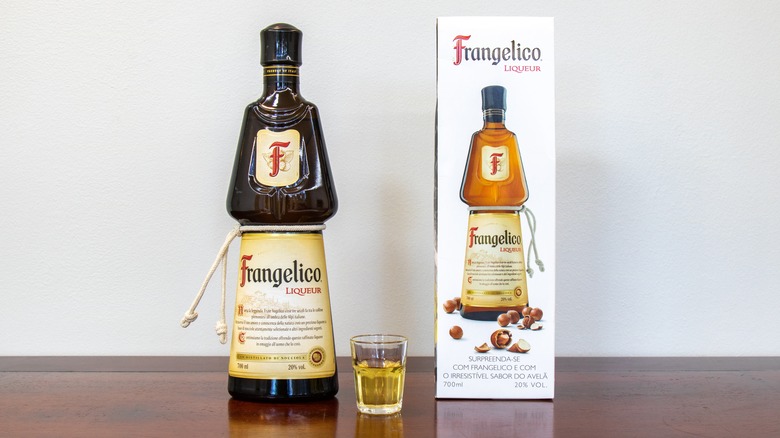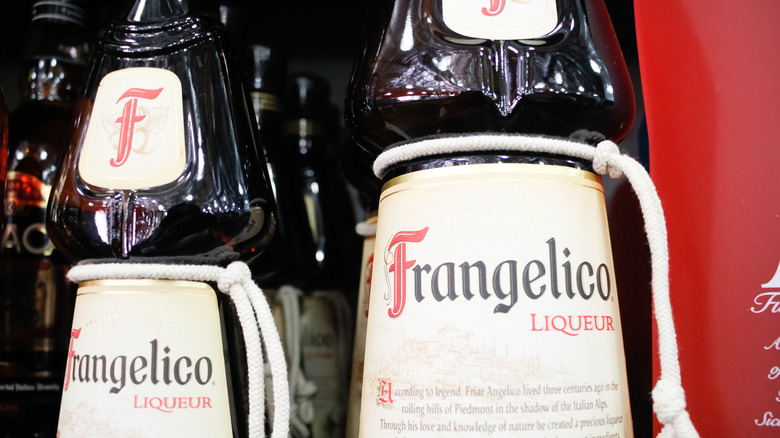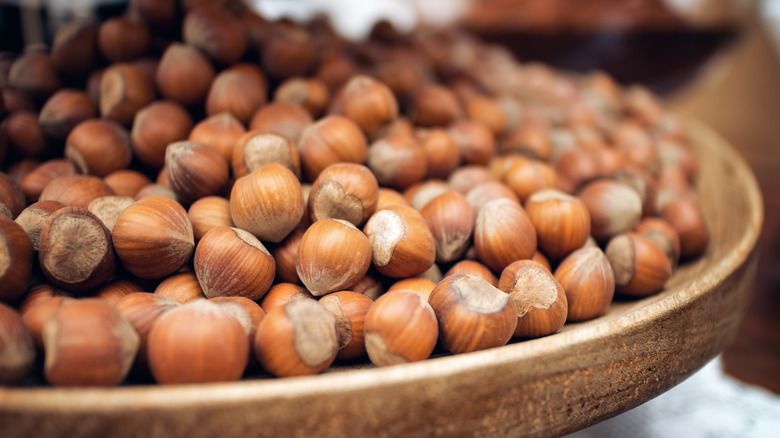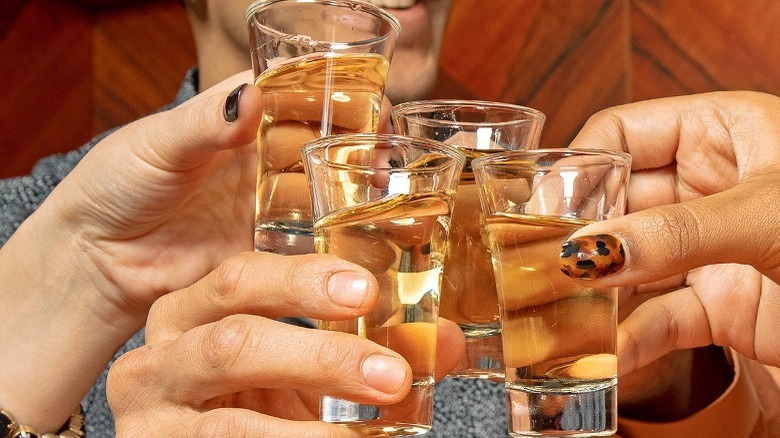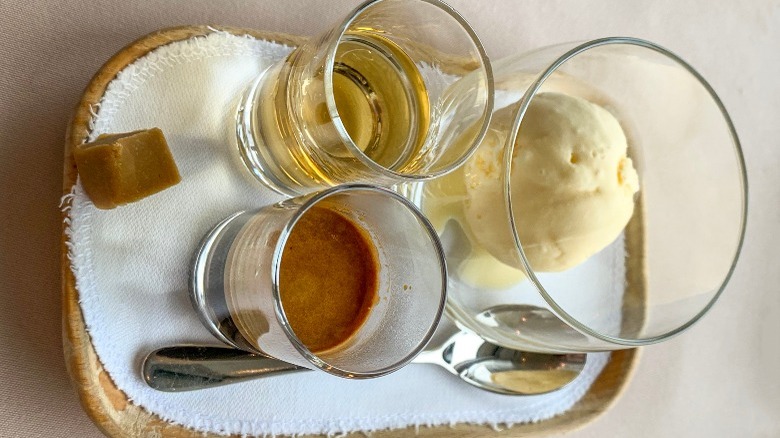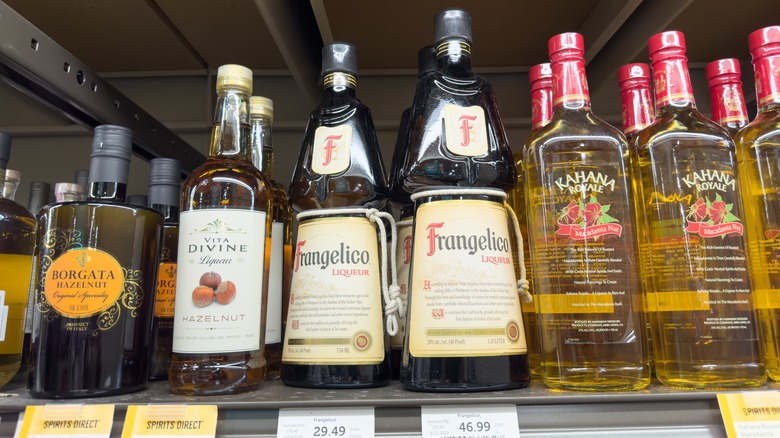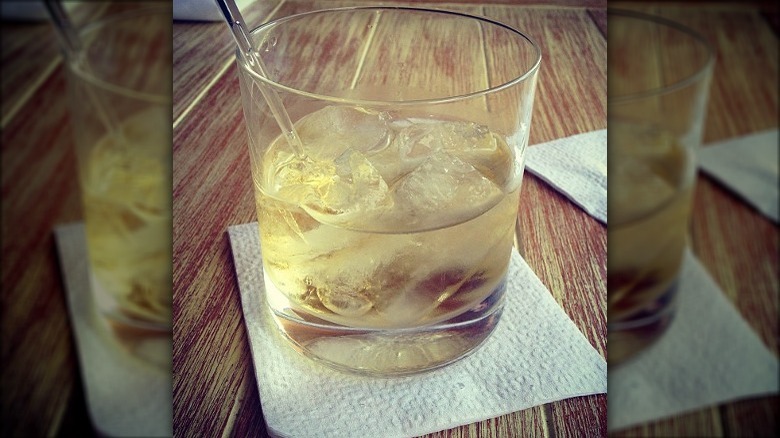Frangelico Is The Flavorful Liqueur With A Rich Italian Origin
If you've ever had a cocktail with a particularly nutty name — literally, in that it was called something along the lines of Nutty Irishman, Nutty Professor, or Nutty Buddy — then you've very likely tasted Frangelico. However, its hazelnut notes may or may not have stood out among the various other drink elements and whipped cream toppings.
While Frangelico isn't the only hazelnut-flavored liqueur, it is one of the most distinctive due to its packaging. Other brands such as Giffard, Fratello, and Baileys Hazelnut Cream come in standard bottle-shaped bottles, but Frangelico is packaged in one that has the shape of a headless Franciscan friar. In fact, the bottle is actually encircled by a knotted white cord meant to mimic the friar's rope belt known as a cincture. Certain collectible Frangelico bottles have even featured a topper that is also in the form of a friar complete with a tonsured head and clutching the straw hat that is still worn by today's Franciscans.
What is Frangelico?
Frangelico is an Italian hazelnut liqueur currently manufactured under the auspices of Gruppo Campari. While the company website touts the possibility that its recipe dates back three centuries, the brand itself is a product of the disco decade. When Frangelico first came out in 1978, it was somewhat stronger than the current version as the original bottle contents were blended at 56 proof or 28% ABV. Over time, however, the alcohol amount was lowered, first to 24% (28 proof) and finally to the current level of 20% ABV (40 proof).
The name Frangelico is said to come from that of a hermit known as Fra ("brother") Angelico who lived in Italy's Piedmont region during the 18th century. He may not have been the one who actually created the liqueur, but a prototype seems to have originated with experimental-minded monks or friars wishing to put Piedmontese produce to good use. (These two types of religious are not one and the same as the former remain cloistered while the latter are active in the local community.) The liqueur's eponym, however, is not to be confused with the Fra Angelico of Renaissance fame. Not only was he a Dominican friar who would not have worn the brown robe depicted on the Frangelico bottle, but he was also more concerned with painting angels and saints than distilling liqueurs out of wild hazelnuts.
How is Frangelico made?
One reason for Frangelico's intensely nutty taste — it may, in fact, be one of the nuttiest-tasting of nut-based liqueurs — is the fact that the first step in the distillation process involves whole, locally-grown hazelnuts. The particular type that goes into this drink is Tonda Gentile, an exceptionally sweet strain of hazelnuts that's also popular with candy makers. Ferrero-Rocher, in fact, also makes use of this type of nut in its products. Once the nuts are picked, the shells are removed and the nut meats toasted. Toasting the nuts brings out their natural oils and deepens the flavor as well as removes any raw nut bitterness. (Sadly, nut toasting can be a pretty tricky process for home cooks, so much so that even Alton Brown can't do it without burning them.)
After being toasted, the (unburnt) nuts are crushed and used to infuse a mixture of water and alcohol. Once the infusion has attained sufficient nuttiness, it's then distilled and flavored with additional ingredients including cocoa seeds, coffee, and vanilla berries. More alcohol is added to the mix, as is additional water and sufficient sugar to give the liqueur its characteristic sweetness. The final step before bottling the Frangelico involves a nice long vat rest of six to eight weeks duration so that all of the different flavors can blend together into a harmonious whole.
What does Frangelico taste like?
In addition to Frangelico's very strong hazelnutty flavor, the predominant flavor note is that syrupy sweetness typical of many liqueurs, plus, of course, the astringency from the alcohol itself. (There is no kind of booze that doesn't taste boozy.) It also has a certain element of chocolaty flavor to it, as well as some vanilla and coffee notes, but this isn't too surprising when you consider the fact that all three ingredients make up its composition in addition to hazelnuts, alcohol, and sugar. In essence, Frangelico tastes exactly like what it is.
Frangelico on its own is pretty much dessert in a glass and as a cocktail ingredient, it tends to be used in super-sweet concoctions. Some mixologists, however, feel that it has the potential to be cloying unless it's used very sparingly. In fact, several bartenders interviewed by Punch suggest that Frangelico should be swapped out for a sweetener like the almond-flavored syrup orgeat rather than being used as a major drink element due to its high level of sugariness.
How to drink and cook with Frangelico
If you really enjoy super-sweet libations, you can always drink Frangelico straight up, on the rocks, or with a splash of milk or cream. It can also be blended with other sweet liqueurs in dessert-like cocktails such as the aforementioned Nutty Irishman, Professor, and Buddy or used to balance out different drink elements such as the bitterness of a negroni or the tartness of a sour. Moreover, you can mix the liqueur with unsweetened coffee in order to temper some of its sweetness or else take the opposite route by going full-on dessert drink and using it in a boozy milkshake, hot chocolate, or affogato.
Frangelico can be a flavoring agent for non-liquid desserts, as well. Its nuttiness pairs particularly well with chocolate in baked goods such as cakes, pies, and brownies, or it can flavor more delicate desserts such as madeleine cookies, chocolate mousse, and tiramisu. Some cooks will even use Frangelico to sweeten up a sauce for a savory dish such as chicken or ribs.
Where to buy Frangelico
Frangelico is a fairly mainstream liqueur so it can generally be found in most major liquor stores, although not every small corner store will necessarily have it unless there's a heavy demand in that specific locale. Depending on state law, it's also something that could be sold by grocery stores as well as big box retailers such as Sam's Club.
It is also possible, again pending state law, to have Frangelico sent directly to you from an online retailer such as Instacart or Shipt or an online liquor store like Uptown Spirits. In fact, the latter retailer even offers this liqueur in three different sizes: 375 milliliters, 750 milliliters, and 1.75 milliliters (the bottle for the last-named quantity makes a rather stout friar). Yet another option, if you don't feel like leaving the house but you want that Nutty Professor sooner rather than later, might be to order a same-day shipment of Frangelico via a booze delivery app such as Drizly or Saucey.
Nutritional information about Frangelico
An ounce of Frangelico contains 103 calories, 11 grams of carbohydrates, and 10.9 grams of sugar. The liqueur has no fat or sodium listed but is also completely lacking in protein as well as any vitamins or minerals. Apart from the empty calories, Frangelico also poses a danger to anyone with tree nut sensitivity because it is made with real hazelnuts instead of synthetic nut flavoring and thus contains allergens that may trigger a bad reaction.
What's more, despite having a lower ABV than spirits such as vodka, whiskey, or rum, Frangelico is still an alcoholic beverage and can lead to intoxication. Depending on your body mass, general health, tolerance for alcohol, and other factors, just two or three shots of a 40-proof liqueur such as Frangelico could have you feeling somewhat impaired. And the more you drink, the more serious the effect will become. As the Centers for Disease Control and Prevention point out, drinking to excess, whether it be of Frangelico or any other alcoholic beverage, can result in a wide range of negative consequences including accidents, risky behavior, violence, and both mental and physical health issues.
